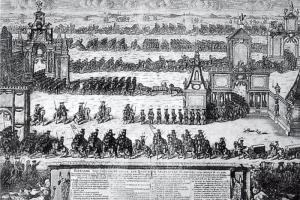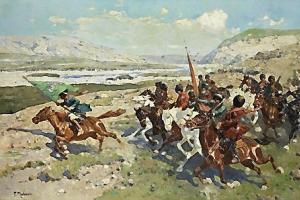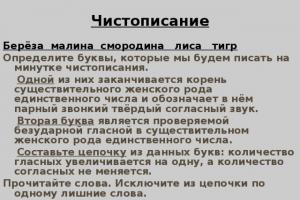About the Caucasian War in brief
Kavkazskaya vojna (1817—1864)
The Caucasian War began
Caucasian War causes
Caucasian War stages
Caucasian War results
The Caucasian War, in short, is a period of prolonged military conflict between the Russian Empire and the North Caucasian Imamate. The war was fought for the complete subjugation of the mountainous regions of the North Caucasus, and is one of the most fierce in the 19th century. Covers the period from 1817 to 1864.
Close relations between Russia and the peoples of the Caucasus began after the collapse of Georgia in the 15th century. Since the 16th century, many oppressed states of the Caucasus range asked for protection from Russia.
The main reason for the Caucasian War, in short, was that Georgia, the only Christian state in the Caucasus, was constantly under attack and attempts to subjugate it from neighboring Muslim countries. Repeatedly, the rulers of Georgia asked for Russian protection. In 1801, Georgia formally became part of the Russian Empire, but was isolated from it by neighboring countries. There was a need to create the integrity of Russian territory. This was possible only with the subjugation of other peoples of the North Caucasus.
Some states became part of Russia almost voluntarily - Kabarda and Ossetia. The rest - Adygea, Chechnya and Dagestan - categorically refused to do this and put up fierce resistance.
In 1817, the main stage of the conquest of the North Caucasus by Russian troops began under the leadership of General A.P. Ermolova. It was after his appointment as commander of the army in the North Caucasus that the Caucasian War began. Until this time, the Russian authorities were rather lenient towards the mountaineers.
The difficulty of conducting military operations in the Caucasus was that at the same time the Russian Empire had to participate in the Russian-Turkish and Russian-Iranian war.
The second stage of the Caucasian War is associated with the emergence of a single leader in Chechnya and Dagestan - Imam Shamil. He managed to unite disparate peoples and start a “gazavat” - a liberation war - against the Russian troops. Shamil was able to quickly create a strong army and for 30 years waged successful military operations with Russian troops, who suffered huge losses in this war.
19 . Russia and the Caucasus in the first half of the 19th century. Caucasian War. Muridism. Gazavat. Imamat of Shamil.
WITH 1817-1864. Russian troops fought in the North Caucasus to annex its territory. These military actions were called - "Caucasian War". This war began under Alexander I, the main burden fell on the shoulders of Nicholas I, and ended under Alexander II.
At the beginning of the 19th century, Georgia itself joined Russia (in Transcaucasia). At that time there was only one way to communicate with Georgia - the so-called Georgian Military Road, built by the Russians through the mountains of the North Caucasus. But movement along this road was in constant danger from robberies from the mountain peoples. The Russians could not limit themselves to repelling the raids. This constant defense was worth more than a major war.
Causes of the Caucasian War: Stop the raids of the mountaineers on the Georgian military road. Annex the territory of the North Caucasus. Do not allow the North Caucasus to pass to Turkey, Iran or England.
What was the North Caucasus like before joining Russia? The territory of the North Caucasus was distinguished by its geographical and ethnic originality.
In foothills and river valleys- in North Ossetia, Chechnya, Ingushetia, and also in Dagestan they were engaged in agriculture, viticulture, and gardening. State formations were formed here - the Avar Khanate, the Derbent Khanate, etc. In mountainous parts In Dagestan and Chechnya, the main branch of the economy was transhumance: in winter, cattle were grazed on the plains and in river valleys, and in the spring they were driven to mountain pastures. In the mountainous regions there were “free societies”, which consisted of unions of several neighboring communities. The free societies were headed by military leaders. The Muslim clergy had significant influence.
The annexation of the Caucasus began after the Patriotic War of 1812. The Russian government expected to solve this problem in a short time. But there was no quick victory. This was facilitated by: the geographical conditions of the North Caucasus and the unique mentality of its peoples; the commitment of individual peoples of the Caucasus to Islam and the idea of gazavat.
The hero of the Patriotic War of 1812, General A.P. Ermolov, was sent to the Caucasus as commander of the Caucasian Corps. He pursued a kind of “carrot and stick” policy. He expanded and strengthened ties with those peoples in the North Caucasus who supported Russia, and at the same time pushed the rebellious ones out of the fertile regions. As the Russians advanced deeper into Chechnya and Dagestan, roads and fortresses were built, such as the fortresses of Groznaya and Vnezapnaya. These fortresses made it possible to control the fertile valley of the Sunzha River.
Russia's aggressive policy in the Caucasus aroused active opposition from the mountain peoples. There was a powerful surge of uprisings in Kabarda (1821-1826), Adygea (1821-1826) and Chechnya (1825-1826). They were suppressed by special punitive detachments.
Gradually, isolated clashes escalated into a war that engulfed the North-West Caucasus, Dagestan, and Chechnya and lasted almost 50 years. The liberation movement was complex. It intertwined: - general dissatisfaction with the arbitrariness of the tsarist administration, - the infringed national pride of the highlanders, - the struggle of the national elite and the Muslim clergy for power.
At the initial stage of the war, Russian troops easily suppressed the resistance of individual detachments of mountaineers. then we had to fight with Shamil’s troops.
In the 20s of the 19th century, among the Muslim peoples of the North Caucasus, especially in Chechnya and Dagestan, muridism(or novitiate). Muridism was led by the Muslim clergy and local feudal lords. This movement was distinguished by religious fanaticism and proclaimed holy war (ghazawat or jihad) against the infidels.In the late 1820s - early 1830s. a military-theocratic state was formed in Chechnya and mountainous Dagestan - imamat. All power in it was concentrated in the hands of the imam - the political and spiritual leader. The only law was Sharia. Arabic was recognized as the official language. In the 30s, imam Shamil became Dagestan. He managed to subjugate Chechnya to his influence. For 25 years Shamil ruled over the highlanders of Dagestan and Chechnya. A disciplined, trained army was created.
In the fight against Russia, Shamil tried to rely on Turkey and England, wanted to receive financial support from them. At first, England actively responded to this proposal. But when the Russians intercepted an English schooner with weapons on board off the Black Sea coast, the British hastened to quell the political scandal with a promise not to interfere in the Caucasian conflict. In the early 50s, Russian troops finally ousted Shamil’s troops into mountainous Dagestan, where they were virtually doomed to a half-starved existence. In 1859, Shamil surrendered to the commander-in-chief of the Russian army in the Caucasus, A.I. Baryatinsky. Shamil was not executed, not thrown into prison, not exiled to Siberia, shackled. He was seen as an outstanding commander and politician who lost with dignity and courage. Shamil was sent to St. Petersburg, where he was celebrated as a hero, to his utter amazement. Kaluga was assigned Shamil's permanent place of residence. There he and his large family were given a magnificent two-story mansion, the inhabitants of which did not feel the need for anything. After ten years of quiet life in this city, Shamil was allowed to fulfill his old dream - to make a pilgrimage to Mecca and Medina, where he died in 1871.
5 years after the capture of Shamil, the resistance of the mountaineers was broken. Russia began to develop new lands.
During the war, the peoples of the North-West Caucasus – the Circassians – fought independently against Russia.(Under this general name there were many different tribal and communal associations). The Circassians raided Kuban. The Caucasian War brought significant human and material losses to Russia. During this entire time, 77 thousand soldiers and officers of the Caucasian Corps died, were captured, or went missing. The material and financial costs were enormous, but they cannot be accurately accounted for. The war worsened Russia's financial situation. The peoples of the North Caucasus lost their independence and became part of Russia. If Russia had not annexed the Caucasus, then other states - Turkey, Iran, England - would still not have allowed the peoples of the Caucasus to exist independently.
In 1817, the Caucasian War began for the Russian Empire, which lasted for almost 50 years. The Caucasus has long been a region into which Russia wanted to expand its influence, and Alexander 1, against the backdrop of successes in foreign policy, decided on this war. It was assumed that success could be achieved in a few years, but the Caucasus has become a big problem for Russia for almost 50 years. The interesting thing is that this war was fought by three Russian emperors: Alexander 1, Nicholas 1 and Alexander 2. As a result, Russia emerged victorious, however, the victory was achieved with great effort. The article offers an overview of the Caucasian War of 1817-1864, its causes, course of events and consequences for Russia and the peoples of the Caucasus.
Causes of the war
At the beginning of the 19th century, the Russian Empire actively directed efforts to seize lands in the Caucasus. In 1810, the Kartli-Kakheti kingdom became part of it. In 1813, the Russian Empire annexed the Transcaucasian (Azerbaijani) khanates. Despite the announcement of submission by the ruling elites and consent to annexation, the regions of the Caucasus, inhabited by peoples mainly professing Islam, declare the beginning of the struggle for liberation. Two main regions are being formed in which there is a sense of readiness for disobedience and armed struggle for independence: Western (Circassia and Abkhazia) and North-Eastern (Chechnya and Dagestan). It was these territories that became the main arena of hostilities in 1817-1864.
Historians identify the following main reasons for the Caucasian War:
- The desire of the Russian Empire to gain a foothold in the Caucasus. And not just to include the territory into its composition, but to fully integrate it, including by extending its legislation.
- The reluctance of some peoples of the Caucasus, in particular the Circassians, Kabardians, Chechens and Dagestanis, to join the Russian Empire, and most importantly, the readiness to conduct armed resistance to the invader.
- Alexander 1 wanted to rid his country of the endless raids of the peoples of the Caucasus on their lands. The fact is that since the beginning of the 19th century, numerous attacks by individual detachments of Chechens and Circassians on Russian territories for the purpose of robbery have been recorded, which created big problems for border settlements.
Progress and main stages
The Caucasian War of 1817-1864 is a vast event, but it can be divided into 6 key stages. Let's look at each of these stages next.
First stage (1817-1819)
This is the period of the first partisan actions in Abkhazia and Chechnya. The relationship between Russia and the peoples of the Caucasus was finally complicated by General Ermolov, who began to build fortified fortresses to control the local peoples, and also ordered the resettlement of the highlanders to the plains around the mountains, for stricter supervision over them. This caused a wave of protest, which further intensified the guerrilla war and further escalated the conflict.
Map of the Caucasian War 1817 1864

Second stage (1819-1824)
This stage is characterized by agreements between the local ruling elites of Dagestan regarding joint military actions against Russia. One of the main reasons for the unification was that the Black Sea Cossack Corps was relocated to the Caucasus, which caused mass discontent in the Caucasus. In addition, during this period, fighting took place in Abkhazia between the army of Major General Gorchakov and local rebels, who were defeated.
Third stage (1824-1828)
This stage begins with the uprising of Taymazov (Beibulat Taymiev) in Chechnya. His troops tried to capture the Grozny fortress, but near the village of Kalinovskaya the rebel leader was captured. In 1825, the Russian army also won a number of victories over the Kabardians, which led to the so-called pacification of Greater Kabarda. The center of resistance completely moved to the northeast, to the territory of the Chechens and Dagestanis. It was at this stage that the current of “muridism” emerged in Islam. Its basis is the duty of gazavat - holy war. For the mountaineers, war with Russia becomes an obligation and part of their religious belief. The stage ends in 1827-1828, when a new commander of the Caucasian corps, I. Paskevich, was appointed.
Muridism is an Islamic teaching about the path to salvation through an associated war - ghazavat. The basis of Murism is the obligatory participation in the war against the “infidels”.
Historical reference
Fourth stage (1828-1833)
In 1828, a serious complication occurred in relations between the highlanders and the Russian army. Local tribes create the first independent mountain state during the war years - the Imamate. The first imam is Ghazi-Muhamed, the founder of muridism. He was the first to declare gazavat to Russia, but in 1832 he died during one of the battles.
Fifth stage (1833-1859)

The longest period of the war. It lasted from 1834 to 1859. During this period, the local leader Shamil declares himself an imam and also declares the gazavat of Russia. His army establishes control over Chechnya and Dagestan. For several years, Russia completely loses this territory, especially during participation in the Crimean War, when all military forces were sent to participate in it. As for the hostilities themselves, they were carried out for a long time with varying degrees of success.
The turning point came only in 1859, after Shamil was captured near the village of Gunib. This was a turning point in the Caucasian War. After his capture, Shamil was taken around the central cities of the Russian Empire (Moscow, St. Petersburg, Kyiv), arranging meetings with the top officials of the empire and veteran generals of the Caucasian War. By the way, in 1869 he was released on a pilgrimage to Mecca and Medina, where he died in 1871.
Sixth stage (1859-1864)
After the defeat of the Shamil Imamate from 1859 to 1864, the final period of the war occurs. These were small local resistances that could be eliminated very quickly. In 1864, they managed to completely break the resistance of the highlanders. Russia ended a difficult and problematic war with victory.
Main results
The Caucasian War of 1817-1864 ended in victory for Russia, as a result of which several problems were solved:
- The final seizure of the Caucasus and the spread of its administrative structure and legal system there.
- Increasing influence in the region. After the capture of the Caucasus, this region becomes an important geopolitical point for increasing influence in the East.
- The beginning of the settlement of this region by Slavic peoples.
But despite the successful conclusion of the war, Russia acquired a complex and turbulent region that required increased resources to maintain order, as well as additional protection measures due to Turkish interests in this area. This was the Caucasian War for the Russian Empire.

Ivan Paskevich
Mamia V (VII) Gurieli
Davit I Gurieli
Georgy (Safarbey) Chachba
Dmitry (Omarbey) Chachba
Mikhail (Khamudbey) Chachba
Levan V Dadiani
David I Dadiani
Nicholas I Dadiani
Mehdi II
Sulaiman Pasha Tarkovsky
Abu Muslim Khan Tarkovsky
Shamsutdin-Khan Tarkovsky
Ahmed Khan II
Musa-bek
Daniyal-bek (until 1844)
Gamzat-bek †
Imam Shamil #
Baysangur Benoevsky #†
Hadji Murat †
Muhammad-Amin
Daniyal-bek (from 1844 to 1859)
Tashev-Hadji †
Kyzbech Tuguzhoko †
Beybulat Taimiev
Haji Berzek Kerantukh
Aublaa Akhmat
Shabbat Marshan
Ashsaw Marchand
Sheikh-Mulla Akhtynsky
Agabek Rutulsky
In the book “Unconquered Chechnya,” published in 1997 after the First Chechen War, public and political figure Lema Usmanov called the war of 1817-1864 “ First Russian-Caucasian War» .
Ermolov - Conquest of the Caucasus
But the tasks facing Ermolov in the North Caucasus required precisely his energy and intelligence. The Georgian Military Road divides the Caucasus into two stripes: to the east of it are Chechnya and Dagestan, to the west is Kabarda, extending to the upper reaches of the Kuban, and then the Trans-Kuban lands inhabited by Circassians. Chechnya with Dagestan, Kabarda and finally Circassia constituted the three main theaters of struggle, and special measures were required in relation to each of them.
Background
| History of Dagestan | |
 |
|
| Dagestan in the ancient world | |
|---|---|
| Dagestan in the Middle Ages | |
| Dagestan in modern times | |
|
Caucasian War |
|
| Dagestan within the USSR | |
| Dagestan after the collapse of the USSR | |
|
History of Dagestan Peoples of Dagestan Portal "Dagestan" |
| History of Chechnya | |
 |
|
| History of Chechnya in the Middle Ages | |
|---|---|
| Chechnya and the Russian Empire | |
|
Caucasian War |
|
| Chechnya in the Civil War | |
| Chechnya in the USSR | |
| Chechnya after the collapse of the USSR | |
|
Portal "Chechnya" |
Russo-Persian War (1796)
Georgia was at that time in the most deplorable state. Taking advantage of this, Agha Mohammed Shah Qajar invaded Georgia and on September 11, 1795, took and ravaged Tiflis. King Irakli with a handful of his entourage fled to the mountains. At the end of the same year, Russian troops entered Georgia and. The Dagestan rulers expressed their submission, except for Surkhai Khan II of Kazikumukh, and the Derbent Khan Sheikh Ali. On May 10, 1796, the Derbent fortress was taken despite stubborn resistance. In June Baku was occupied. The commander of the troops, Lieutenant General Count Valerian Zubov, was appointed instead of Gudovich as the chief commander of the Caucasus region; but his activities there were soon put to an end by the death of Empress Catherine. Paul I ordered Zubov to suspend military operations. Gudovich was again appointed commander of the Caucasian Corps. Russian troops were withdrawn from Transcaucasia, except for two battalions left in Tiflis.
Annexation of Georgia (1800-1804)
Russo-Persian War
In the same year, Tsitsianov also subjugated the Shirvan Khanate. He took a number of measures to encourage crafts, agriculture and trade. He founded the Noble School in Tiflis, which was later transformed into a gymnasium, restored the printing house, and sought the right for Georgian youth to receive education in higher educational institutions of Russia.
Uprising in South Ossetia (1810-1811)
Philip Paulucci had to simultaneously wage war against the Turks (from Kars) and against the Persians (in Karabakh) and fight the uprisings. In addition, during the leadership of Paulucci, Alexander I received statements from the Bishop of Gori and the vicar of the Georgian Dosifei, the leader of the Aznauri Georgian feudal group, raising the issue of the illegality of granting the Eristavi princes feudal estates in South Ossetia; The Aznaur group still hoped that, having ousted the Eristavi representatives from South Ossetia, it would divide the vacated possessions among themselves.
But soon, in view of the impending war against Napoleon, he was summoned to St. Petersburg.
In the same year, an uprising broke out in Abkhazia led by Aslanbey Chachba-Shervashidze against the power of his younger brother Safarbey Chachba-Shervashidze. The Russian battalion and the militia of the ruler of Megrelia, Levan Dadiani, then saved the life and power of the ruler of Abkhazia, Safarbey Chachba.
Events of 1814-1816
Ermolovsky period (-)
In September 1816, Ermolov arrived at the border of the Caucasus province. In October he arrived on the Caucasian Line in the city of Georgievsk. From there he immediately went to Tiflis, where the former Commander-in-Chief, Infantry General Nikolai Rtishchev, was waiting for him. On October 12, 1816, by the highest order, Rtishchev was expelled from the army.
"Opposite the center of the line lies Kabarda, once populous, whose inhabitants, considered the bravest among the mountaineers, often, due to their large population, desperately resisted the Russians in bloody battles.
...The pestilence was our ally against the Kabardians; for, having completely destroyed the entire population of Little Kabarda and wreaked havoc in Big Kabarda, it weakened them so much that they could no longer gather in large forces as before, but made raids in small parties; otherwise our troops, scattered in weak parts over a large area, could be in danger. Quite a few expeditions were undertaken to Kabarda, sometimes they were forced to return or pay for the abductions made."(from the notes of A.P. Ermolov during the administration of Georgia)
«… Downstream of the Terek live the Chechens, the worst of the bandits who attack the line. Their society is very sparsely populated, but has increased enormously in the last few years, for the villains of all other nations who leave their land due to some kind of crime were received in a friendly manner. Here they found accomplices, immediately ready either to avenge them or to participate in robberies, and they served as their faithful guides in lands unknown to them. Chechnya can rightly be called the nest of all robbers..." (from the notes of A.P. Ermolov during the administration of Georgia)
« I have seen many peoples, but such rebellious and unyielding people as the Chechens do not exist on earth, and the path to the conquest of the Caucasus lies through the conquest of the Chechens, or rather, through their complete destruction».
« Sovereign!.. The mountain peoples, by example of their independence, give rise to a rebellious spirit and a love of independence in the very subjects of your Imperial Majesty" From the report of A. Ermolov to Emperor Alexander I on February 12, 1819.
In the spring of 1818, Ermolov turned to Chechnya. In 1818, the Grozny fortress was founded in the lower reaches of the river. It was believed that this measure put an end to the uprisings of the Chechens living between Sunzha and Terek, but in fact it was the beginning of a new war with Chechnya.
Ermolov moved from individual punitive expeditions to a systematic advance deep into Chechnya and Mountainous Dagestan by surrounding mountainous areas with a continuous ring of fortifications, cutting clearings in difficult forests, laying roads and destroying rebellious villages.
The highlanders who threatened Tarkovsky’s Shamkhalate annexed to the empire were pacified. In 1819, the Vnezapnaya fortress was built to keep the mountaineers submissive. An attempt to attack it by the Avar Khan ended in complete failure.
In Chechnya, Russian forces drove detachments of armed Chechens further into the mountains and resettled the population to the plain under the protection of Russian garrisons. A clearing was cut in the dense forest to the village of Germenchuk, which served as one of the main bases of the Chechens.

Map of the Caucasus. 1824.

Central part of the Caucasus. 1824.
Its result was the consolidation of Russian power in Kabarda and the Kumyk lands, in the foothills and plains. The Russians advanced gradually, methodically cutting down the forests in which the mountaineers were hiding.
The beginning of gazavat (-)
The new commander-in-chief of the Caucasian Corps, Adjutant General Paskevich, abandoned a systematic advance with the consolidation of occupied territories and returned mainly to the tactics of individual punitive expeditions. At first he was mainly occupied with wars with Persia and Turkey. Successes in these wars helped maintain external calm, but muridism spread more and more. In December 1828, Kazi-Mulla (Ghazi-Muhammad) was proclaimed imam. He was the first to call for gazavat, seeking to unite the disparate tribes of the Eastern Caucasus into one mass hostile to Russia. Only the Avar Khanate refused to recognize his power, and Kazi-Mulla’s attempt (in 1830) to take control of Khunzakh ended in defeat. After this, the influence of Kazi-Mulla was greatly shaken, and the arrival of new troops sent to the Caucasus after the conclusion of peace with Turkey forced him to flee from the Dagestan village of Gimry to the Belokan Lezgins.
In the Western Caucasus, a detachment of General Velyaminov penetrated to the mouths of the Pshada and Vulana rivers in the summer of 2009 and laid down the Novotroitskoye and Mikhailovskoye fortifications there.
In September of the same 1837, Emperor Nicholas I visited the Caucasus for the first time and was dissatisfied with the fact that, despite many years of efforts and major sacrifices, Russian troops were still far from lasting results in pacifying the region. General Golovin was appointed to replace Baron Rosen.
Meanwhile, hostilities began on the Black Sea coast, where the hastily built Russian forts were in a dilapidated state, and the garrisons were extremely weakened by fevers and other diseases. On February 7, the highlanders captured Fort Lazarev and destroyed all its defenders; On February 29, the same fate befell the Velyaminovskoye fortification; On March 23, after a fierce battle, the highlanders penetrated the Mikhailovskoye fortification, the defenders of which blew themselves up along with the attackers. In addition, the highlanders captured (April 2) the Nikolaev fort; but their enterprises against the Navaginsky fort and the Abinsky fortification were unsuccessful.
On the left flank, the premature attempt to disarm the Chechens caused extreme anger among them. In December 1839 and January 1840, General Pullo conducted punitive expeditions in Chechnya and destroyed several villages. During the second expedition, the Russian command demanded the surrender of one gun from 10 houses, as well as one hostage from each village. Taking advantage of the discontent of the population, Shamil raised the Ichkerinians, Aukhovites and other Chechen societies against the Russian troops. Russian troops under the command of General Galafeev limited themselves to searching in the forests of Chechnya, which cost many people. It was especially bloody on the river. Valerik (July 11). While General Galafeev was walking around Lesser Chechnya, Shamil with Chechen troops subjugated Salatavia to his power and in early August invaded Avaria, where he conquered several villages. With the addition of the elder of the mountain societies in the Andean Koisu, the famous Kibit-Magoma, his strength and enterprise increased enormously. By the fall, all of Chechnya was already on Shamil’s side, and the means of the Caucasian line turned out to be insufficient to successfully fight him. The Chechens began to attack the tsarist troops on the banks of the Terek and almost captured Mozdok.
On the right flank, by the fall, a new fortified line along the Labe was secured by forts Zassovsky, Makhoshevsky and Temirgoevsky. The Velyaminovskoye and Lazarevskoye fortifications were restored on the Black Sea coastline.
The failures of the Russian troops spread in the highest government spheres the conviction that offensive actions were futile and even harmful. This opinion was especially supported by the then Minister of War, Prince. Chernyshev, who visited the Caucasus in the summer of 1842 and witnessed the return of Grabbe’s detachment from the Ichkerin forests. Impressed by this catastrophe, he convinced the tsar to sign a decree prohibiting all expeditions to the city and ordering them to limit themselves to defense.
This forced inaction of the Russian troops emboldened the enemy, and attacks on the line became more frequent again. On August 31, 1843, Imam Shamil captured the fort at the village. Untsukul, destroying the detachment that was going to the rescue of the besieged. In the following days, several more fortifications fell, and on September 11, Gotsatl was taken, which interrupted communication with Temir Khan-Shura. From August 28 to September 21, the losses of Russian troops amounted to 55 officers, more than 1,500 lower ranks, 12 guns and significant warehouses: the fruits of many years of effort were lost, long-submissive mountain societies were cut off from Russian forces and the morale of the troops was undermined. On October 28, Shamil surrounded the Gergebil fortification, which he managed to take only on November 8, when only 50 of the defenders remained alive. Detachments of highlanders, scattering in all directions, interrupted almost all communications with Derbent, Kizlyar and the left flank of the line; Russian troops in Temir Khan-Shura withstood the blockade, which lasted from November 8 to December 24.
Battle of Dargo (Chechnya, May 1845)
In May 1845, the tsarist army invaded the Imamate in several large detachments. At the beginning of the campaign, 5 detachments were created for actions in different directions. Chechen was led by General Liders, Dagestan by Prince Beibutov, Samur by Argutinsky-Dolgorukov, Lezgin by General Schwartz, Nazranov by General Nesterov. The main forces moving towards the capital of the Imamate were headed by the commander-in-chief of the Russian army in the Caucasus, Count M. S. Vorontsov.
Without encountering serious resistance, the 30,000-strong detachment passed through mountainous Dagestan and on June 13 invaded Andia. At the time of leaving Andia for Dargo, the total strength of the detachment was 7940 infantry, 1218 cavalry and 342 artillerymen. The Battle of Dargin lasted from July 8 to July 20. According to official data, in the Battle of Dargin, the tsarist troops lost 4 generals, 168 officers and up to 4,000 soldiers. Many future famous military leaders and politicians took part in the 1845 campaign: governor in the Caucasus in 1856-1862. and Field Marshal Prince A.I. Baryatinsky; Commander-in-Chief of the Caucasian Military District and chief commander of the civilian unit in the Caucasus in 1882-1890. Prince A. M. Dondukov-Korsakov; Acting commander-in-chief in 1854 before arriving in the Caucasus, Count N.N. Muravyov, Prince V.O. Bebutov; famous Caucasian military general, chief of the General Staff in 1866-1875. Count F. L. Heyden; military governor, killed in Kutaisi in 1861, Prince A.I. Gagarin; commander of the Shirvan regiment, Prince S. I. Vasilchikov; adjutant general, diplomat in 1849, 1853-1855, Count K. K. Benckendorff (seriously wounded during the campaign of 1845); Major General E. von Schwarzenberg; Lieutenant General Baron N.I. Delvig; N.P. Beklemishev, an excellent draftsman who left many sketches after his trip to Dargo, also known for his witticisms and puns; Prince E. Wittgenstein; Prince Alexander of Hesse, Major General, and others.
On the Black Sea coastline in the summer of 1845, the highlanders attempted to capture forts Raevsky (May 24) and Golovinsky (July 1), but were repulsed.
From the city on the left flank, actions were carried out aimed at strengthening control over the occupied lands, erecting new fortifications and Cossack villages and preparing further movement deep into the Chechen forests by cutting down wide clearings. Victory of the book Bebutov, who wrested from the hands of Shamil the inaccessible village of Kutish, which he had just occupied (currently included in the Levashinsky district of Dagestan), resulted in a complete calming of the Kumyk plane and the foothills.
On the Black Sea coastline there are up to 6 thousand Ubykhs. On November 28, they launched a new desperate attack on the Golovinsky fort, but were repulsed with great damage.
In the city, Prince Vorontsov besieged Gergebil, but due to the spread of cholera among the troops, he had to retreat. At the end of July, he undertook a siege of the fortified village of Salta, which, despite the significant siege weapons of the advancing troops, held out until September 14, when it was cleared by the highlanders. Both of these enterprises cost the Russian troops about 150 officers and more than 2,500 lower ranks who were out of action.
The troops of Daniel Bek invaded the Jaro-Belokan district, but on May 13 they were completely defeated at the village of Chardakhly.
In mid-November, Dagestan mountaineers invaded Kazikumukh and briefly captured several villages.
An outstanding event in the city was the capture of Gergebil (July 7) by Prince Argutinsky. In general, for a long time there has not been such calm in the Caucasus as this year; Only on the Lezgin line were frequent alarms repeated. In September, Shamil tried to capture the Akhta fortification on Samur, but he failed.
In the city, the siege of the village of Chokha, undertaken by Prince. Argutinsky, cost the Russian troops great losses, but was not successful. From the Lezgin line, General Chilyaev carried out a successful expedition into the mountains, which ended in the defeat of the enemy near the village of Khupro.
In the city, systematic deforestation in Chechnya continued with the same persistence and was accompanied by more or less serious clashes. This course of action forced many hostile societies to declare their unconditional submission.
It was decided to adhere to the same system in the city. On the right flank, an offensive was launched to the Belaya River in order to move the front line there and take away the fertile lands between this river and the hostile Abadzekhs.
The final event for the final entry of the Caucasus into Russia was the Caucasian War.
The annexation of Transcaucasia to Russia forced the Russian government to rush to conquer the North Caucasus. For Russia, the Caucasus was necessary in the interests of defending its southern borders and as a stronghold in economic and military penetration into the Near and Middle East. At first, they tried to persuade the mountain feudal lords to switch to Russian citizenship through diplomatic means. The mountaineers easily accepted political obligations and just as easily violated them. In response to this, punitive “searches” were carried out against the mountain feudal lords who violated the oath. Tsarism developed an energetic offensive in the mountainous regions of the Caucasus. He was opposed mainly by two groups of the mountain population: firstly, the peasantry, who suffered from the oppression of numerous exactions, duties and cruel methods of warfare, and, secondly, the clergy, dissatisfied with the fact that their privileges were infringed upon by the Russian command and bureaucracy. The clergy tried to completely direct the discontent of the peasants in a certain direction of “gazavat” (“holy war”) against the Russian “guiaurs” (“infidels”) under the banner of the religious and political doctrine - muridism. The main thing in muridism was the idea of the extermination of “guiaurs” and “equality of the faithful before God.” One of the most active organizers of armed uprisings under the flag of muridism in Dagestan and Chechnya in the early 20s was Mullah Muhammad Yaragsky. Being a murshid, i.e. mentor of the murids, he approved one of them, Muhammad from the village of Gimry, as “imam of Dagestan and Chechnya.” Having received the title of Ghazi, i.e. A fighter for the faith (in Gazavat), he gained fame under the name Gazi-Muhammad (often called Kazi-Mulla). Taking advantage of the growing discontent among the mountaineers, he began to energetically spread the ideas of Murism and the slogans of Gazavat and quickly achieved significant success.
In 1829, a significant part of the population of Dagestan rose at his call to fight for the faith (gazavat) against the Russians. In the eastern part of the North Caucasus, only the capital of Avaria, the village of Khunzakh, remained loyal to Russia. Therefore, Gazi-Muhammad (Kazi-Mulla) directed his first blow against this village.
Kazi-Mulla's two attempts to take Khunzakh were unsuccessful. Then he and his murids moved to Northern Dagestan, where he won a number of victories: he took the city of Tarki and the village of Paraul, besieged the Burnaya fortress and, having failed to capture it, moved to Sulak. There, after an unsuccessful attempt in August to take the Vnezapnaya fortress, Kazi-Mulla was driven back by the troops of the tsarist general G.A. Emmanuel, but he soon defeated this general and, inspired by the victory, moved south, besieged Derbent, and then, 8 days later, quickly marched north and on November 1, 1831 captured one of the most important centers of the North Caucasus - Kizlyar. Without stopping there, Kazi-Mulla sent his troops to the west and, entering Chechnya, crossed Sunzha and surrounded Nazran. In response to these actions, the commander-in-chief of the tsarist troops in the North Caucasus, General G.V. Rosen in the summer of 1831 undertook a campaign in Greater Chechnya, where he ravaged 60 villages and destroyed many gardens, forcing the residents to stop resistance. Then G.V. Rosen entered Dagestan and began an energetic pursuit of Kazi-Mulla. The latter, under the pressure of reinforced Russian troops, retreated to the mountains and there, in a major battle near his native village of Gimry, he suffered a complete defeat and himself fell in battle. [4, p. 238]
Two years after the death of Kazi-Mulla, Gamzat-bek was proclaimed the second imam, on the instructions of the same Muhammad of Yaragsky. Like his predecessor, he tried to subjugate rebellious societies and villages into the movement not only by promoting muridism, but also by force of arms. Having captured the capital of the Avar Khanate, Khunzakh, in 1834, which Kazi-Mulla had unsuccessfully tried to capture at one time, Gamzat-bek destroyed the entire family of Avar khans. This turned against him the large feudal lords of Dagestan and the elders of the taips and villages of Eastern Chechnya. At the end of the same year, 1834, in the Khunzakh mosque, Gamzat-bek was killed by relatives of the Avar Khan.
At the end of 1834, the mountaineer movement was led by a new - third imam - Shamil, who was undoubtedly a highly gifted person.
From the very beginning of his imamate, Shamil tried several times to negotiate with the royal command to conclude peace. But due to intransigence on both sides, underestimation by the tsarist command of the anti-colonial sentiments of the highlanders, as well as the authority and abilities of Shamil, the negotiations were interrupted.
Shamil widely propagated Koranic slogans about universal equality and freedom, and destroyed those feudal lords who collaborated with the Russian authorities. Not the entire population of Northern Dagestan and Greater Chechnya followed Shamil.
In the first period, Shamil managed to win over the popular masses of Dagestan and Chechnya and win a number of major victories. In 1834, the troops of General Lansky were defeated in a battle near the village of Gimry, which had already gone down in the history of the anti-colonial struggle of the highlanders.
In 1834-1835 An uprising began against the Russian authorities in the southeastern part of Chechnya - Ichkeria. It was headed by a native of this area, Tashov Hadji. From the Grozny fortress in 1835, troops under the command of Colonel Pullo tried to break into Ichkeria, but met stubborn resistance in the mountainous wooded area.
In 1835-1836 the combined forces of Dagestanis and Chechens opposed the rebellious villages who did not want to join the movement. At the same time, Shamil made an attempt to take possession of the capital of the Avaria - Khunzakh. However, all attacks were repelled by the actual leader of the Avar Khanate, Hadji Murat. Subsequently, they united together with the Tashov-Khadzhi detachments and the leader of the rebels in the Tiletl region, Kibit-Mukhammed, and began to actively act against Russian troops in Mountainous Dagestan and Eastern Chechnya.
In July 1836, Shamil sent a letter to Russian General F.K. Klugenau with a proposal to enter into negotiations with him, as the ruler of the population of the mountainous regions of Dagestan and Chechnya. However, the negotiations came to nothing.
During 1838, Shamil, having settled in the village of Chirkato, launched active efforts to unite the forces of the rebels. In 1839, the Caucasian command launched a two-pronged attack on the North Caucasus. General E.A. Golovin “pacified” Southern Dagestan, and General P.Kh. Grabbe with several battalions began an attack on Ichkeria. The first battle took place on May 31, 1838 for the village of Argun. Within two months, the troops of P.Kh. Grabbe was besieging the high mountain fortress of Ahulgo. Only on August 22 the troops of P.Kh. Grabbe, at the cost of huge losses, managed to capture this fortress. Shamil and his surviving associates went to the highlands of Chechnya.
In 1840 - 1842 Shamil's troops inflicted a number of major defeats on the militias of the Dagestan feudal lords and the troops of General F.K. Klugenau. At the end of 1842, his recent opponent Hadji, Murat, came over to Shamil. In 1842-1843. Shamil's troops won victories over the tsarist troops in Avaria and in a major battle near the village of Kharachoya in Chechnya. Shamil's troops captured Khunzakh and began an attack on flat Dagestan. After these victories, almost all of Dagestan and Greater Chechnya came under the rule of Shamil.
In 1844, Nicholas I appointed Lieutenant General M.S. as governor in the Caucasus and commander of the Caucasian Corps. Vorontsova.
In the spring of 1845, Vorontsov, at the head of several regiments, began the Dargin expedition, a campaign against the village of Dargo - the residence of Shamil, which was taken after several bloody battles.
In 1846, Shamil, at the head of a 10,000-strong detachment, made his way through the Sunzha line and invaded Kabarda, hoping to rouse the Kabardians to fight and thereby create a “second front” for the Russian army. However, this enterprise was not successful, and Shamil was forced to return to Dagestan.
In the fall of 1846, the troops of M.S. Vorontsova launched an attack on Greater Chechnya and Dagestan from several sides. In 1847, the movement led by Shamil began to decline. Its participants gradually lost faith in Shamil and moved away from him.
Shamil's military actions in the late 40s of the 19th century took on the character of scattered partisan actions, his attempts to retain the subject villages of Chechnya and Dagestan failed.
On July 25, 1847, under the direct command of M.S. Vorontsov begins a campaign against the village of Salty. But only on September 14, Russian troops manage to capture this village with heavy losses.
In June 1848, Russian troops took the previously impregnable Gergebel. Shamil was forced to retreat to Eastern Dagestan.
In 1849-1852. Russian troops achieved major successes in Chechnya, which put Shamil in a difficult position.
Since the end of 1856, the troops of General A.I. Baryatinsky, the new governor in the Caucasus, began a decisive attack on Shamil’s last possessions from Chechnya, from the Caspian regions of Dagestan and from the southwest - from the Lezgin cordon line. Particular attention was paid to troubled Chechnya. Shamil dug in at his residence in Vedeno, from where he sent a representative to negotiate peace with the Russian ambassador.
Negotiations with Shamil broke down. Gunib, the last stronghold of Shamil, to which he retreated after the loss of his residence in Vedeno, was taken by storm by Russian troops on August 25, 1859. Shamil surrendered and was soon sent into honorable exile in Kaluga, where his entire family was then transported.
After Shamil, it was the turn of Magomed - Emin. The troops landed from the ships captured Tuapse - the only port through which the highlanders of the North-West Caucasus were supplied with weapons and ammunition. On December 2, 1859, Magomed-Emin and the Abazekh elders swore allegiance to the Russian Empire. However, the appearance of Russian settlers in the Caucasus led to discontent among the local population and the uprising of the peoples of Abkhazia in 1862.
It was suppressed only in June 1864. After this, individual partisan detachments in the Caucasus fought against the Russians until 1884, but large-scale hostilities ended twenty years earlier.
The struggle of the highlanders of the North Caucasus in the 30-50s. XIX century difficult to assess unambiguously. It was certainly national liberation. On the other hand, Muridism, as an extremely extremist direction of Islam, having managed to raise and unite the mountaineers, could not and could not envisage positive solutions to the internal political and foreign policy problems of the Caucasus.
Thus, the entry of the North Caucasus into Russia created favorable conditions for the socio-economic development of the peoples of the region, because the threat of invasions by foreign invaders was removed. The socio-economic conditions of Russia, which were more developed than in Turkey or Iran, opened up better prospects for economic and cultural development for them.








